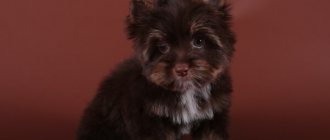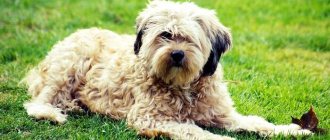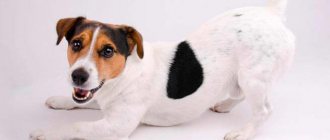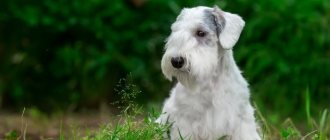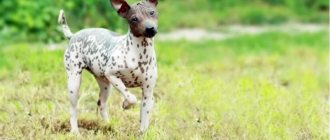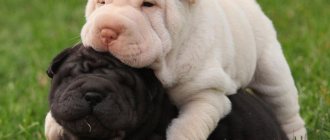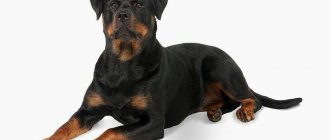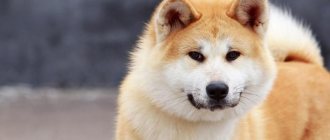The Tibetan Terrier, which attracts attention with its shiny, elongated coat, separated by an even parting in the upper body and on the head, although outwardly reminiscent of indoor Yorkies, belongs to a different group of dogs. The breed, which has existed for more than 2 thousand years, has changed little, since it was bred in mountainous areas inaccessible to people, and was recognized by international organizations only in 1956.
History of the appearance of the Tibetan Terrier breed
Tibetan Terriers have remained purebreds for many thousands of years. This is due to the geographical location of Tibet, as well as its political isolation, which lasted for hundreds of years.
These dogs were highly valued by Tibetan monks and were known as the "sacred dogs of Tibet." For their intelligence and amazing devotion to their owners, the monks nicknamed Tibetan terriers “little people.”
It was believed that these animals brought good luck to the house, which is why giving or selling them was a very bad omen.
Tibetan terriers appeared in Europe thanks to the Englishwoman Crale, who was a doctor and helped the family of a famous merchant. In gratitude for this, she was given a Tibetan terrier puppy.
Mating
To obtain offspring, it is better to contact a kennel club. Both the female and the male must have show grades that are sufficient for breeding.
The first mating can be carried out when the female has reached the age of 1.5 years, and the male has reached 1 year. But it is still better to postpone mating until the age of 2-2.5 years, because that is when the body reaches full maturity.
Important! You can introduce a couple on a walk, but for mating you should prefer the territory of the male.
The breed should be prepared in advance for mating by choosing a high-quality pair
Breed Features
Tibetan Terriers are medium in size and square in shape.
- Their height is no more than 35 cm - 41 cm, and these animals weigh about 10 kg.
- The Tibetan Terrier has a medium-sized head and drooping ears.
- They are covered with long hair and resemble the letter V in appearance.
A distinctive feature of the Tibetan Terrier breed is the presence of wide paws with fairly large pads, which allows the animal to easily move through large snowdrifts in winter.
Tibetan terriers are covered with a double layer of wool, which reliably protects them in severe frosts. The animal's tail is curled into a ring and also covered with long, thick hair.
Shih Tzu mix
To obtain designer dogs, breeders also breed Yorkshire Terriers and Shih Tzus. Puppies born as a result of such crossing are called Shorkies.
Distinctive features of these dogs are their compact size, wide but cute muzzle and body type, reminiscent of a Shih Tzu.
Most individuals have the same color as the Yorkshire Terrier, but some individuals have spots of different shades on the coat.
Character of the Tibetan Terrier breed
The character of Tibetan terriers is their most striking distinguishing feature. These are very active and agile animals with a soft and friendly disposition. At the same time, they are quite calm, love children and easily become full-fledged members of the family. They are always loyal to their owners and quickly become attached to people.
At the same time, Tibetan terriers have a very sensitive nature, mature slowly, and therefore require gradual and delicate training. In order for a willful puppy to turn into a calm, properly trained dog, he needs socialization, a patient and gentle attitude.
Pekingese mix
Mixed breeds of Yorkshire terriers and Pekingese (Yorkinese) have a very pretty appearance, complemented by an aristocratic character, but they are quite rare, because these dogs have fragile health.
It is also absolutely impossible to predict what the puppies resulting from such crossing will be like, because the best qualities of their parents are not always passed on to them.
Often an undesirable mixture of characteristics is found in puppies, which is determined by poor coat, squinting eyes, an unformed skull, a non-closed fontanel and other problems.
Rules for caring for a dog
Tibetan terriers are able to easily adapt to different living conditions, and are also not picky in everyday life. However, to maintain good external condition of the animal, it is necessary to regularly care for its thick, long hair.
- To do this you will need a special toothed brush.
- It is necessary to comb the animal's fur with massage movements in the direction of hair growth.
- Water procedures are also necessary for the health and beauty of the Tibetan Terrier.
And in order for your pet not to suffer from tartar and other dental problems, it needs a special bone.
How to choose a puppy
This dog becomes truly desirable for many people. Demand is growing, so the number of nurseries raising this breed is increasing. When choosing a baby, it is important to carefully monitor his behavior. You shouldn’t choose a puppy based on a photo; it’s better to come and watch him in person. It is important to examine the dog's eyes and ears; they should be clean and free of excess discharge.
Important! The baby's behavior should be playful. At the age of 2 months, dogs are extremely inquisitive.
Choosing a nickname
Among the popular nicknames for this dog:
- Rick;
- Thomas;
- John;
- Dobie;
- Jesse;
- Missy;
- Lizzie;
- Ani.
Choosing a name for a pet is a fairly important decision, because even the character of the animal often corresponds to how it was named.
Caring for puppies
Puppies up to 2 months old must remain with their mother. Before this age, children should not be separated from dogs and milk. Particularly responsible breeders do not give away puppies before 3 months of age. During this time, the animal is given all the necessary vaccinations and helmitized.
Tibetan Terrier with maximally grown hair
Feeding the Tibetan Terrier dog
A distinctive condition for feeding the Tibetan Terrier is maintaining a varied diet. This is necessary to maintain the health of the animal’s gastrointestinal tract, as well as for the beauty of the coat and the general condition of the body.
Desirable foods for feeding a dog include: Bones, meat, vegetables and all kinds of cereals.
- Tibetan Terrier puppies need frequent, 7-8 meals a day in small portions.
- For an adult animal, the number of meals is reduced and the portion size is increased.
- Tibetan Terriers are very fond of sea fish, beef and dairy products.
Pet food
Nutrition is an important part in a dog’s life, because it affects its health. It should be natural and balanced; the age, weight and height of the dog also play an important role.
The diet must include the following products:
- lean meat
- fish fillet
- porridge
- vegetables
- dairy products.
The exception is potatoes, any baked goods, fatty foods and bones.
Training
The advantage of early (from the first months of life) training of Tibetan terriers is the instillation in the puppy of socialization skills and proper behavior in the house. Despite their friendly nature, these animals do not get along well with other pets. They can also be stubborn and not respond to their owner's voice.
Therefore, the Tibetan Terrier needs regular walks, during which he can get to know other dogs. In order for an animal to successfully memorize a particular command, it must be repeated many times.
It is quite difficult for a dog that has not reached maturity to concentrate its attention for a long time, so the training process should be varied and interesting.
Appearance
A medium-sized breed of square format with strong, harmonious, fairly strong, but not heavy bones. The muscles are powerful, but not dry. The skin is tight-fitting. Too heavy, rough, loose bones or muscles are serious shortcomings; great attention is paid to the harmony of the physique. At the same time, representatives of the breed have a clearly defined sexual type. Males are more powerful, fluffier, stockier than females. When judging, the build of male dogs is standardized more strictly. An elongated body shape is considered a disadvantage. Paws that are too high or a long or arched back are considered a fault.
Health
Tibetan Terriers are distinguished by their resistance to various colds. They are not afraid of hypothermia and do not get sick if they suddenly find themselves in the cold with wet fur.
- However, these animals are completely devoid of immunity from viral infections, which is why they need an annual trip to the veterinarian for vaccination.
- Unfortunately, this breed of dog has a predisposition to hereditary diseases.
- Among them, the most common is deformation of the hip joint, leading to poor coordination and difficulty moving.
- Tibetan Terriers also often suffer from eye diseases: progressive retinal atrophy, cataracts and lens luxation.
Coat and color
These dogs have elastic, wrinkle-free skin. An exception is Tibetan Terrier puppies under the age of 15 months, they may exhibit slight folding.
- Dogs of this breed are distinguished by the presence of a dense and thick undercoat, which is quite soft and long. Healthy Tibetan Terriers have a shiny, elastic coat that falls beautifully into even partings.
- Dogs are distinguished by their natural coloring, which harmoniously matches the color of their lips, eyelids and nose. The colors of the Tibetan Terrier are varied, but the main colors include: white, black, gray, peach and golden.
- If you pay attention to the photo of the Tibetan Terrier, you cannot help but notice how cute these pets are. When wondering how much a Tibetan terrier costs, you should remember that the price of a Tibetan terrier depends on many factors: The type of animal, its age, pedigree, color.
The Tibetan Terrier is the most suitable dog breed for those who are looking for an intelligent, good-natured and loyal pet.
Owner reviews
Natalia:
Our favorite is already 12 years old. I can say that I don’t know a smarter dog of this size. After walking, she immediately runs into the bathtub, jumps on the washbasin and waits for her to be washed. It was difficult to stop barking over trifles. I had to seek advice from a dog handler. But after that you can hardly hear her. The kids are simply delighted with the dog. And his daughter, who grew up with him, carries Ronnie with her everywhere, pretending to be a lady with a dog. Grooming is absolutely not stressful and even brings pleasure. And he really doesn’t get underfoot, but always tries to be nearby.
Ksenia:
It's just a miracle, not a dog. It’s just a pity that we don’t have a nursery, and we had to go fifty kilometers to get her. Our Tusya is incredibly kind and affectionate. And how we love to make a mess... She even raises her paws to make it easier for me to brush her. A real lady, and very proud and capricious. If she didn’t like something, then for the rest of the day she can pretend that she was offended. We are also very smart. We learned everything very quickly and without any problems. Walking with her is simply a pleasure. Every now and then you hear enthusiastic comments.
It is important and interesting for us to know your opinion about the breed, which, according to Tibetan monks, brings happiness. Tell us about your wonderful pets, as any advice on keeping Tibetan Terriers will be useful to us.
Rate this article
Share
Leave a review
